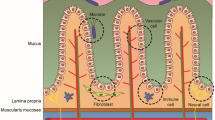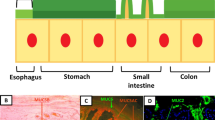Abstract
Bioadhesion (and mucoadhesion) is the process whereby synthetic and natural macromolecules adhere to mucosal surfaces in the body. If these materials are then incorporated into pharmaceutical formulations, drug absorption by mucosal cells may be enhanced or the drug released at the site for an extended period of time. For synthetic polymers, such as the chitosans, carbopols and carbomers, the mechanism of bio/mucoadhesion is the result of a number of different physicochemical interactions. Biological bio/mucoadhesives, such as plant lectins, show specific interactions with cell surfaces and mucin and are seen as the ‘second generation’ bioadhesives.
Bioadhesive systems for drug administration via the buccal and nasal cavities are nearing the market; in the case of nasal bioadhesion, bioadhesive microparticles are used. A bioadhesive formulation for drug administration to the vagina is in use. The gastrointestinal tract is proving a more difficult site because of the rapid turnover of mucus, and relatively constant transit time, but intensive research is in progress. Micro- and nano-particles, coated with either bio/mucoadhesive polymers or specific biological bioadhesives, are showing some promise, but will require considerable research and development before reaching the market.

Similar content being viewed by others
References
Davenport HW. Physiology of the digestive tract. Chicago: Year Book Medical Publishers, 1982
Gu J-M, Robinson JR, Leung S-H, et al. Binding of acrylic polymers to mucin/epithelial surfaces: structure-property relationships. CRC Crit Rev Ther Drug Carrier Syst 1988; 5: 21–67
Peppas NA, Buri PA. Surface, interfacial and molecular aspects of polymer bioadhesion on soft tissues. J Contr Rel 1985; 2: 257–75
Bernkop-Schnürch A, Schwarz V, Steininger S. Polymers with thiol groups: a new generation of mucoadhesive polymers? Pharm Res 1999; 16: 876–81
Marschütz MK, Caliceti P, Clausen AE, et al. Design and in vivo evaluation of an oral delivery system for insulin [abstract 8416]. Proceedings of the International Symposium on Controlled Release Bioactive Materials; 2000 Jul 10–13; Paris. 27
Lee JW, Park JH, Robinson JR. Bioadhesive-based dosage forms: the next generation. J Pharm Sci 2000; 89: 850–66
Ali J, Khar RK, Ahuja A. Formulation and characterisation of a buccoadhesive tablet for the treatment of oral lesions. Pharmazie 1998; 53: 329–34
Beysacc E, Touaref F, Meyer M, et al. Bioavailability of morphine after administration of a new bioadhesive buccal tablet. Biopharm Drug Dispos 1998; 19: 401–5
Agarwal V, Mishra B. Design, development, and biopharmaceutical properties of buccoadhesive compacts of pentazocine. Drug Dev Ind Pharm 1999; 25: 701–9
Gutniak MK, Larsson H, Heiber SJ, et al. Potential therapeutic levels of glucagon-like peptide I achieved in humans by a buccal tablet. Diabetes Care 1996; 19: 843–8
Li C, Bhatt PP, Johnston TP. Transmucosal delivery of Oxytocin to rabbits using a mucoadhesive buccal patch. Pharm Dev Tech 1997; 2: 265–74
3M buccal drug delivery system [promotional literature]. St Paul (MN): 3M, 2000
Columbia Laboratories. Progesterone bioadhesive vaginal gel: scientific description. Available from URL: http://www.columbialabs.com/html/crinhealth/progesterone/gel.htm. [Accessed 2001 Jan 23]
Brown D, Henzl MR, Kaufman RH. Butoconazole nitrate 2% for vulvovaginal candidiasis. New, single-dose vaginal cream formulation vs. seven day treatment with miconazole nitrate. Gynazole 1 Study Group. J Reprod Med 1999; 44: 933–8
Coos Verhoef J, Merkus FWHM. Nasal absorption enhancement: relevance to nasal drug delivery. In: de Boer AG, editor. Drug absorption enhancement: concepts, possibilities, limitations and trends. Chur: Harwood Academic Publishers, 1994: 119–53
Hinchcliffe M, Ilium L. Intranasal insulin delivery and therapy. Adv Drug Del Rev 1999; 35: 199–234
Artursson P, Lindmark T, Davis SS, et al. Effect of chitosan on the permeability of monolayers of intestinal epithelial cells (Caco-2). Pharm Res 1994; 11: 1358–61
Schipper NGM, Olsson S, Hoogstraate JA, et al. Chitosans as absorption enhancers for poorly absorbable drugs 2: mechanism of absorption enhancement. Pharm Res 1997; 14: 923–9
Soane RJ, Frier M, Perkins AC, et al. Evaluation of the clearance characteristics of bioadhesive systems in humans. Int J Pharm 1999; 178: 55–65
Fernandez-Urrusuno R, Calvo P, Remunan-Lopez C, et al. Enhancement of nasal absorption of insulin using chitosan nanoparticles. Pharm Res 1999; 16: 1576–81
Ilium L. Chitosan and its use as a pharmaceutical excipient. Pharm Res 1998; 15: 1326–31
Witschi C, Mrsny RJ. In vitro evaluation of microparticles and polymer gels for use as nasal platforms for protein delivery. Pharm Res 1999; 16: 382–90
El-Shafy MA, Kellaway IW, Taylor G, et al. Improved nasal bioavailability of FITC-dextran (Mw 4300) from mucoadhesive microspheres in rabbits. J Drug Target 2000; 7: 355–61
Callens C, Remon JP. Evaluation of starch-maltodextrin-Carbopol 974 P mixtures for the nasal delivery of insulin in rabbits. J Cont Rel 2000; 66: 215–20
Ugwoke MI, Agu RU, Jorissen M, et al. Nasal toxicological investigations of Carbopol 971P formulation of apomorphine: effects on ciliary beat frequency of human nasal primary cell culture and in vivo on rabbit nasal mucosa. Eur J Pharm Sci 2000; 9: 387–96
Alpar HO, Eyles JE, Williamson ED. Oral and nasal immunization with microencapsulated clinically relevant proteins. STP Pharm Sci 1998; 8: 31–9
Alonso MJ. Recent strategies for vaccine formulation in biodegradable polymer particles [abstract 0218]. Proceedings of the International Symposium on Controlled Release Bioactive Materials; 2000 Jul 10–13; Paris, 27
Bourlais CL, Acar L, Zia H, et al. Ophthalmic drug delivery systems. Prog Retin Eye Res 1998; 17: 33–58
Gurtler F, Kaltsatos V, Boisrame B, et al. Ocular availability of gentamycin in small animals after topical administration of a conventional eye drop solution and novel long acting bioadhesive ophthalmic drug insert. Pharmacol Res 1995; 12: 1791–5
Zimmer AK, Chetoni P, Saettone MF, et al. Evaluation of pilocarpine-loaded albumin particles as controlled drug delivery systems for the eye. II: Co-administration with bioadhesive and viscous polymers. J Cont Rel 1995; 33: 31–46
Genta I, Conti B, Perugini P, et al. Bioadhesive microspheres for ophthalmic administration of acyclovir. J Pharm Pharmacol 1997; 48: 737–42
Longer MA, Ch′ng HS, Robinson JR. Bioadhesive polymers as platforms for the oral controlled drug delivery III: oral delivery of chlorothiazide using a bioadhesive polymer. J Pharm Sci 1985; 74: 406–11
Tur KM, Ch′ng HS, Baie S. Use of a bioadhesive polymer to improve the bioavailability of griseofulvin. Int J Pharm 1997; 148: 63–71
Riley RG, Green KL, Smart JD, et al. The gastrointestinal transit profile of 14C-labelled poly(acrylic acids): an in-vivo study [abstract]. J Pharm Pharmacol 2000; 52 Suppl.: 168
Davis SS, Hardy JG, Fara JW. Transit of pharmaceutical dosage forms through the small intestine. Gut 1986; 27: 886–92
Thanou M, Florea BI, Langemeyer MWE, et al. N-trimethylated chitosan chloride (TMC) improves the intestinal permeation of the peptide drug buserelin in vitro (Caco-2 cells) and in vivo in rats. Pharm Res 2000; 17: 27–31
Luessen HL, de Leeuw BJ, Langemeyer MW, et al. Mucoadhesive polymers in peroral peptide drug delivery: VI. Carbomer and chitosan improve the intestinal absorption of the peptide drug buserelin in vivo. Pharm Res 1996; 13: 1668–72
Woodley JF, Naisbett B. The potential of lectins for delaying the intestinal transit of drugs. Proc Int Symp Contr Rel Bioact Mater 1988; 15: 125–6
Naisbett B, Woodley J. The potential use of tomato lectin for oral drug delivery: 1. Lectin binding to rat small intestine. Int J Pharm 1994; 107: 223–30
Naisbett B, Woodley J. The potential use of tomato lectin for oral drug delivery: 3. Bioadhesion in vivo. Int J Pharm 1995; 114: 227–36
Lehr CM, Bouwstra JA, Kok W, et al. Bioadhesion by means of specific binding of tomato lectin. Pharm Res 1992; 9: 547–53
Irache JM, Durrer C, Duchêne D, et al. In vitro study of lectinlatex conjugates for specific bioadhesion. J Cont Rel 1994; 31: 181–8
Lehr C-M, Pusztai A. The potential of bioadhesive lectins for the delivery of peptide and protein drugs to the gastrointestinal tract. In: Pusztai A, Bardocz S, editors. Lectins: biomedical perspectives. London: Taylor and Francis, 1995: 117–40
Montisci M-J. Dêveloppment de sytémes bioadhésifs par conjugaison de microsphéres de poly (D,L-lactide) á la lectin de Lycopersicon esculentum. L. ou de Lotus tetragonolobus. Etude de la distribution gastro-intestinale aprés administration orale chez le rat [dissertation]. Paris: University Paris XI, 1998
Gabor F, Bernkop-Schnurch A, Hamilton G. Bioadhesion to the intestine by means of E. coli K99-fimbriae: gastrointestinal stability and specificity of adherence. Eur J Pharm Sci 1997; 5: 233–42
Hussain N, Florence AT. Utilizing bacterial mechanisms of epithelial cell entry: invasin-induced oral uptake of latex nanoparticles. Pharm Res 1998; 15: 153–6
Hussain N, Jani PU, Florence AT. Enhanced oral uptake of tomato lectin-conjugated nanoparticles in the rat. Pharm Res 1997; 14: 613–8
Foster N, Clark MA, Jepson MA, et al. Ulex europaeus 1 lectin targets microspheres to mouse Peyer’s patch M-cells in vivo. Vaccine 1998; 16: 536–41
Ertl B, Heigl F, Wirth M, et al. Lectin-mediated bioadhesion: preparation, stability and caco-2 binding of wheat germ agglutinin-functionalized poly(D,L-lactic-co-glycolic acid)microspheres. J Drug Target 2000; 8: 173–84
Wroblewski S, Kopeckova P, Rihova B, et al. Lectin-HPMA copolymer conjugates — drug carriers for gastrointestinal tract targeting. Proc Int Symp Contr Rel Bioact Mater 1998; 25: 768–9
Kawashima Y, Yamamoto H, Takeuchi H, et al. Mucoadhesive DL-lactide/glycolide copolymer nanospheres coated with chitosan to improve oral delivery of elcatonin. Pharm Dev Tech 2000; 5: 77–85
Lavelle EC, Grant G, Pusztai A. Mucosal immunogenicity of plant lectins in mice. Immunology 2000; 99: 30–7
Acknowledgements
The author is a Fellow in the School of Life Sciences, Keele University, England, and is most grateful to the University for the facilities thus afforded to him.
Author information
Authors and Affiliations
Corresponding author
Rights and permissions
About this article
Cite this article
Woodley, J. Bioadhesion. Clin Pharmacokinet 40, 77–84 (2001). https://doi.org/10.2165/00003088-200140020-00001
Published:
Issue Date:
DOI: https://doi.org/10.2165/00003088-200140020-00001




